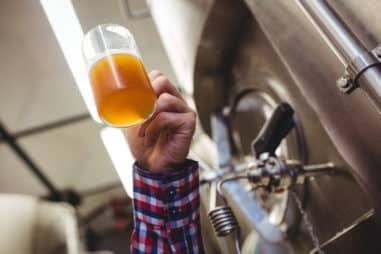Even though Lagers are the most preferred beer by Americans in terms of pure beer sales, warm-fermenting Ale is easier to homebrew. For starters, you don’t need much of those fancy chilling devices required by lager yeasts. The lesser the involved components, the lesser the chance of making mistakes.
This quick read will give you heating tips and tricks so you can enjoy your homebrew in no time!
Does Heat Affect Fermentation?
Heat or Thermal Energy definitely influences fermentation. In the same fashion the sun brings life and motion to the inhabitants of the earth, heat is the energy that enables lifeforms to do their thing. In this particular case, it will be affecting beer-making microbes.
Does Fermentation Require Warmth?
It depends on what you mean by “warmth.” It is not fermentation that has a requirement per se. To be precise, yeasts “require” a certain working temperature range to do meaningful work. Work in terms of the alcohol production you know and love.
Now if you are talking about the fundamental temperature ranges of beer-making, the question makes more sense. Warmth, in the context of homebrewing beer, most likely refers to the “warmer” ale-brewing temperatures. These temperatures are “warmer” than those used for lagers.
On the other hand, if you are asking about lagers, its yeasts require less heat energy to do worthwhile manufacture of alcohol. So you could say with confidence that it needs warmth. Therefore, fermentation does require warmth albeit at varying levels.
Why Does Fermentation Require a Warm Temperature?
Fermentation of ales requires warm temperatures simply because it is the specification of the yeast itself.
You can have a better insight by analyzing human specifications. Your normal body temperature is generally around 98.6°F (37°C). The “normal” body temperature actually ranges from 97 to 99°F (36.1 to 37.2°C). You can only do things effectively within this range, more or less.
With this newfound insight, you can conclude that ale yeasts require a warm temperature. This is by virtue of the temperature being part of the vital properties of the organism. And by extension, affects fermentation performance.
Can You Speed Up Fermentation With Heat?
Theoretically, inputting energy into a system should make more energy available for all the components of the system to consume, i.e. yeast. Generally speaking, the more energy in a system, the more work can be done. For yeasts, this means more reproduction and sugar-to-alcohol conversion.
Outside of theory, the researchers Krzysztof Kucharczyk and Tadeusz Tuszyński acquired empirical proof in their research paper “The effect of temperature on fermentation and beer volatiles at an industrial scale.” They found that there is some level of inverse proportionality between temperature and process time. In simple terms, the higher the temperature, the shorter the time it takes to complete fermentation.
Of course, this generalization is not infinitely scalable since you can only heat or cool something so much until you do serious damage.
Moreover, the idea of speeding up homebrewing should not be your priority. You need to focus on making the best beer you possibly can, however long that may take. Haste makes waste and all that.
Why Does Heat Speed Up Fermentation?
There are so many known, unknown, dependent, and mutually exclusive factors that affect the speed of fermentation. These factors have their own individual optimal temperature ranges. Take for example the enzymes from yeasts that do the actual sugar breakdown and conversion. Some of these enzymes improve performance at the back end of the working temperature of yeast.
Also, empirical observations of yeast show that temperature affects their multiplication. You can effectively increase the workforce by subjecting them to warmer temperatures.
How Warm Should Fermentation Be?
When brewing ales, the temperature you should be aiming for your fermentation liquid is a temperature within 68 to 72 °F (20 to 22 °C). This will really depend on the recipe so you do not have to take this as dogma.
Does Heat Stop Fermentation?
When you reach a certain high heat threshold, fermentation stops. This fact is used by brewers to pasteurize beer when it is deemed the appropriate time to do so. Normally this is done at the end of the maturation phase of beer-making to improve shelf-life. Of course, this ultimately depends on the type of beer.
What Temperature Is Too High for Fermentation?
A good reference for high temperature is the temperature when you, a human, are considered sick. A temperature of 100°F (38°C) is indicative of a fever. Fever temperatures are designed to subdue microorganisms, so it is a good place to start as a warning.
As you increase the temperature from this danger baseline, you will slowly be losing yeast. And when you hit the border between microbe life and death, 140°F (60 °C), your workforce is guaranteed to be devastated.
What Happens if Fermentation Temperature Is Too High?
It will mark the end of your brewing adventure. Your yeast population will either be totally spent or outright dead.
If you prematurely end the fermentation, you will have to re-seed your brew with fresh and pre-conditioned starter cultures. But the chances of success at this point is, well… do not get your hopes up too much.
How to Keep Beer Warm During Fermentation
Passive warming during fermentation is the most cost-effective way to warm up. This is especially true if you did not anticipate the need for heating. You can try some of these household items lying around:
- Folded Blankets,
- a sheet of Foam Insulation,
- a sheet of Fiberglass Insulation, or
- a sheet of Rock Wool Insulation
You simply have to wrap these materials around your homebrew fermentation vessel and you are done. For the insulation sheets, though, you might need to do some measuring and cutting. Take care when handling construction materials. You need to be aware of their Material Safety Data. Otherwise, just stick to the blankets.
Some of these items are more “household” than others. You never know with your neighbors, though.
How to Do Hot Fermentation
Trapping the heat generated from fermentation using the passive approach is great. However, there are also active heating options. Such options are for brewers hellbent on temperature control.
Some of these methods can be thought of as odd but get the job done.
- Submerge in Hot Water. If you have a big enough container to hold the volume of your fermenter and some water, you can use an aquarium-type heater. Remember to check for reasonable clearances all around the vessel in the container.
- Brew Belt. This is an electric heater that wraps its sheathed heating element around your fermenter. Check the recommended fermenting vessel material before using this device. Some manufacturers only work with certain plastic carboys.
- Space Heater. If you have a working space with a heater, it should work well for your purpose. If you are using an electric heater, routine supervision is needed to avoid incidents since fermentation takes quite a while.
- Old Unused Refrigerator/Freezer. Couple this with a small space heater installation within, and you have yourself the Ultimate Solution. Although, setting it up can be a real hassle if you do not know what you are doing.
Beers Brewed With a Warm Fermentation Method
Typically, and historically, all ales are brewed using warm fermentation. But just to give you a taste, here are some beers that follow this norm:
- American Pale Ale. The American answer to the English Pale Ale. It was the frontrunner of the most popular American craft beer before IPAs came along.
- Golden Ale. A previously summer beer that showcases hops. It is also known as Golden Bitter thanks to being well-hopped.
- Old Ale. Known for its age-related personality in terms of having hints of Brettanomyces action, aka barnyard funk.
- Witbier. Smooth, creamy, and hazy from wheat, yeast, and perhaps a touch of oats. Highly lively and sparkly.
- Lambic. Per Brussels tradition, it is a spontaneously fermented beverage that is refreshingly acidic. Whether its tart charm is good or bad is a matter of personal preference.
Warm Fermentation Lagers
Lagers are supposedly fermented “cold,” 45 to 55 °F (7 to 13 °C), so warm-fermented lagers are somewhat of an oddity. Nevertheless, it is possible, and it has been done to some degree of success.
Now, to make your very own warm-fermented lager, you not so simply apply ale yeast’s “warm” temperatures in lieu of the cold ferment. It is not trivial because you need to apply a little finesse in temperature management.
Warm Fermentation Pilsner
For a specific example of a warm-fermentation lager, you can try the recipe of a German Pilsner. You then apply the warm-fermentation method at the back end of the recipe (steps 5 & 6).
Here is a quick overview of the recipe as an example to give inspiration, but not to be used as a step-by-step guide:
- Gather up your base malts.
- German Pilsner Malt
- Victory Malt
- Gather up your hops.
- Warrior at 15% alpha acid
- Hallertau at 4% alpha acid
- Prepare your yeast, a German Lager strain.
- Undergo all the preparatory and brewing processes.
- Ferment the wort within 57 to 62°F (14 to 17°C) for the first three – four days during the most active phase of fermentation.
- Advance the fermentation temperature to the “warm” ale levels, 68 to 70°F (20 to 21°C), for two weeks.








